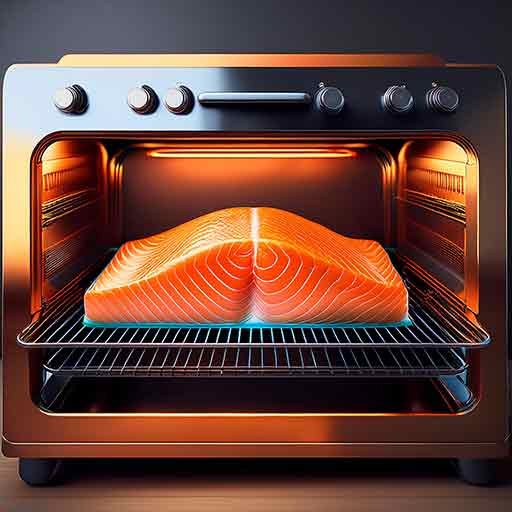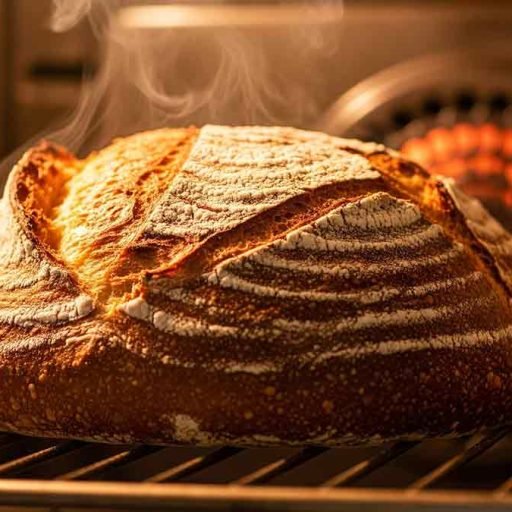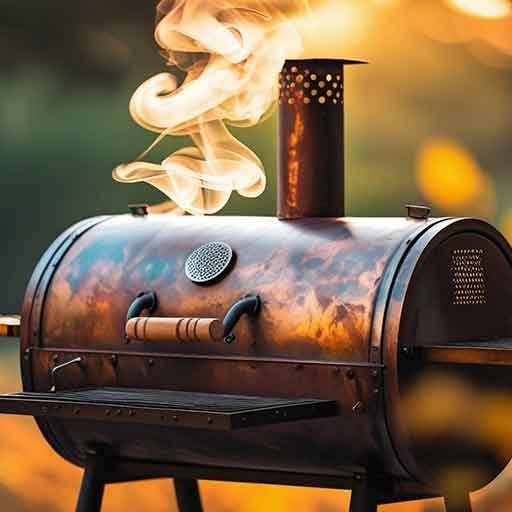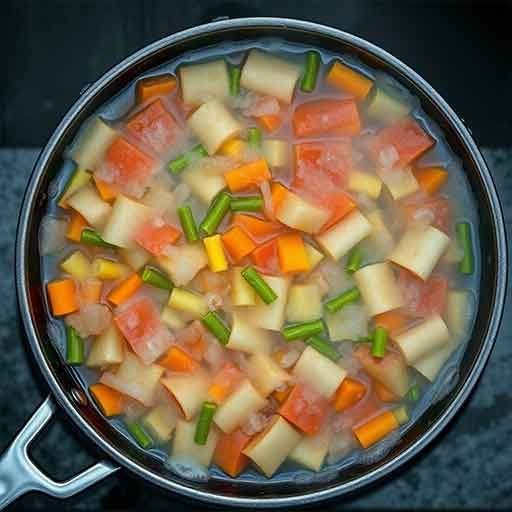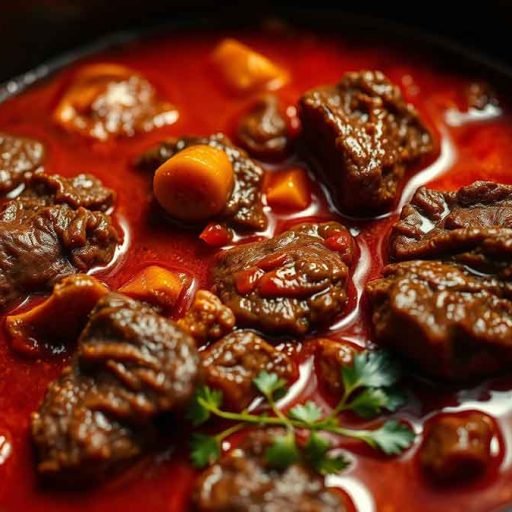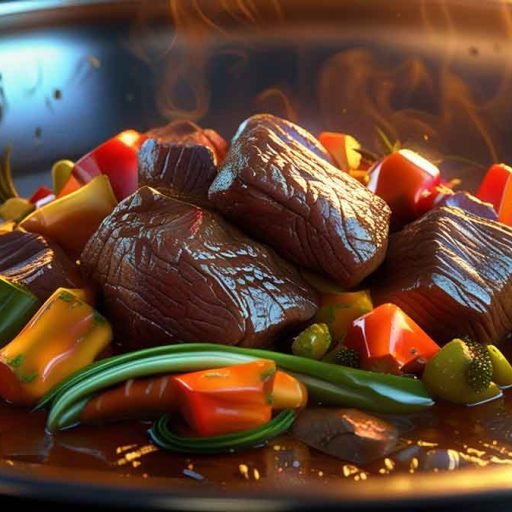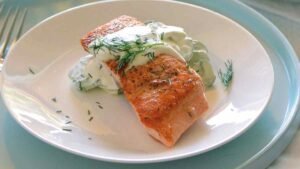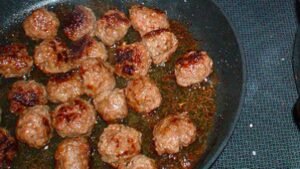Broiling is a cooking method that directly uses infrared radiant heat from an overhead source such as an overhead broiler or salamander to cook food. in simple this seems like grilling from a top heat source. Temperatures at the heat source can be as low as 550 °F (288 °C) and as high as 2000°F (1093°C), whereas larger commercial appliances broil between 700 and 1,000 °F (371 and 538 °C). The food to be cooked is placed on a preheated metal grate. Radiant heat from above cooks the food, while the hot grate below creates attractive crosshatch marks.
Broling is a cooking technique to add crispness, Color, and flavor to roasted or baked food. Broiled shrimp, for example, show cross-hatch marks from the broiler on the presentation side, the surface that is exposed when the plate is presented to the guest.
Delicate foods that may be damaged by placing them directly on the metal grill or foods that do not want crosshatch marks can be placed on a preheated heatproof platter and under the broiler. For example, tender fish fillets such as flounder, Which may break during cooking, are broiled on a heatproof platter.
Only relatively firm and dry fruits and vegetables are suitable for broiling.
Cooking is done by indirect heat from the preheated platter as well as direct heat from the broiler’s overhead heat source. Broiling is considered a healthy cooking method when it is used to make lean cuts of meat, poultry or fish, fruits, and vegetables as long as little or no fat is added.
What is a Broiler?
A broiler is a source of radiant heat on the top of an oven or in a bottom broiler drawer. In an electric oven, a coil is attached to the top of the oven. In a gas oven, there is a burner on the top of the oven or in a drawer underneath that slides in and out.
Broiling Guidelines, Size, and Time Chart
Note: All cook times are based on beef removed directly from the refrigerator
| Beef Cut | Weight/ Thickness | Distance from Heat Inches | Approximate Total Cooking Time Minutes Medium Rare(145°F) to Medium (160°F) |
|---|---|---|---|
| CHUCK | (inches) | (minutes) | |
| Shoulder Top Blade steak (Flat Iron) | 8-oz each | 3 to 4 | 15 to 20 |
| Shoulder Steak, Bonless(Marinate) | 3/4 inch 1 inch | 2 to 3 3 to 4 | 10 to 13 16 to 21 |
| RIB | (inches) | (minutes) | |
| Rib Steak, Small end | 3/4 inch 1 inch | 2 to 3 3 to 4 | 9 to 12 13 to 17 |
| Ribeye Steak | 3/4 inch 1 inch | 2 to 3 3 to 4 | 8 to 10 14 to 18 |
| LOIN | (inches) | (minutes) | |
| Porterhouse/ T-bone Steak | 3/4 inch 1 inch | 2 to 3 3 to 4 | 10 to 13 15 to 20 |
| Top Loin (Strip) steak, boneless | 3/4 inch 1 inch | 2 to 3 3 to 4 | 9 to 12 13 to 17 |
| Tenderloin steak | 1 inch 1-1/2 inches | 2 to 3 3 to 4 | 13 to 16 18 to 22 |
| SIRLOIN | (inches) | (minutes) | |
| Top Sirloin steak, Bonless | 3/4 inch 1 inch 1-1/2 inches 2 inches | 2 to 3 3 to 4 3 to 4 3 to 4 | 9 to 12 19 to 21 26 to 31 34 to 39 |
| ROUND Recommend cooking Round cuts to medium rare (145°F) doneness only | (inches) | (minutes) | |
| Top Round steak (marinate) | 3/4 inch 1 inch 1-1/2 inches | 2 to 3 1 to 3 3 to 4 | 12 to 13 17 to 18 27 to 29 |
| Bottom Round steak(Western Griller) (marinate) | 1-1/4 inches | 3 to 4 | 18 to 20 |
| PLATE & FLANK | |||
| Flank steak (marinate) | 1-1/2 to 2 pounds | 2 to 3 | 13 to 18 |
| OTHER | |||
| Ground Beef patties Cook to medium (160°F) doneness. | 1/2 inch (4-oz each) 3/4 inch (6-oz each) | 2 to 3 3 to 4 | 12 to 13 12 to 14 |
| Kabobs, beef only | 1 pound 1 x 1-1/4-inch cubes | 3 to 4 | 7 to 11 |
How To Broil
Broiling is a cooking method Use an electric Oven called a Broiler and the act of cooking in a broiler is called broil. Let’s Start broil
How to Prepare Broiler for Broiling
- Heat the overhead broiler or salamander to its highest setting.
- if necessary, use a wire brush to remove any charred or burnt particles stuck to the broiler grate. The grate can be wiped with a lightly oiled towel to remove any remaining particles and to help season it.
How to Prepare Food for Broiling
- Cut, trim, or otherwise prepare the food to be broiled. (Foods should be cut to an even thickness.
- Thicker pieces of food take longer to cook.) Marinate, rub or season food, as desired.
- Many foods can be brushed lightly with oil to keep them from sticking to the grate.
How To Place Food In Broiler
- 4 Pull out the broiler grate and place the food on it, presentation side down.
- Slide the grate back under the broiler.
- if necessary, use a chef’s fork or tongs to turn or flip the item without piercing its surface.
How To Cook Food In a Broiler
- Cook the food to the desired degree of doneness while developing the proper surface color.
- To do so, adjust the position of the item on the broiler grate, or change the distance between the grate and the heat source.
- if practical, rotate the food 90 degrees to produce attractive crosshatch marks.
- Doneness is often determined by touch, internal temperature, or specific visual cues (e.g., clear juices running from poultry).
- Smaller pieces of food can often be cooked closer to the source of heat.
- Remove the cooked item from the broiler grate.
Determining Doneness
Determining the doneness of foods cooked with dry heat methods is an inexact science. As celebrity chef Andre Soltner observed, “One must cook a piece of meat a thousand times before one begins to understand how it cooks.” This is It’s impossible to tell the exact time to cook meat, poultry, and fish because there are so many variables.
Red Meat

Beef, lamb, and some game meats can be cooked to the limit of donations. Determining precisely when a piece of meat has reached the right doneness can only be learned through experience. However, contact and appearance cues are not exact but serve as guidelines.
Touch
Press the meat with a fingertip and gauge its resistance. The less well-done a piece of meat is, the tenderer and more productive it will feel.
Recognizing Doneness through Touch:
To practice recognizing the feel of meat cooked to various stages of doneness:
- Hold one hand open, palm up, with the fingers slightly curled
- Touch the flesh at the base of the thumb; it will feel soft and yielding
- As the fingers are gradually spread open and flat, the flesh will feel increasingly less yielding
Appearance
As the meat cooks, the exterior should be dark brown. If the meat looks pale or even brown, it is not cooked properly. The juice that comes out of the meat, though minimal, should be the right color. The more rare the meat, the “bloody” juices should appear.
Recognizing Doneness through Appearance:
The changes that meat undergoes in color also can help determine doneness. Beef cooked:
- “Blue” has a very deep maroon color
- Rare has a very pronounced red interior, but it is no longer maroon
- Medium has a rosy pink interior and is not quite as juicy
- Well-done has no traces of red or pink and although still somewhat moist in appearance, it is no longer juicy
White Meat

Veal and poultry should be cooked through, but not overcooked. The meat should have a small amount of “give” when pressed with a fingertip. Any juice that comes out of the meat should either show a “pink thread” or be almost colorless.
Even thin cuts of meat will retain some heat, allowing them to continue to cook (carry over) after being removed from the heat and stored. If the meat is not left tender, it may be overcooked by the time it is served.
Fish and Shellfish

They are very easy to cook because of their delicacy. Their connective tissues and proteins cook at low temperatures, so heat can travel quickly throughout the fish. The fish should offer only minimal resistance when pressed with a fingertip.
Choosing the Right Fish for Broiling
Choose firm-meat varieties like wild king salmon, Northwest Pacific halibut, or Pacific black cod. These fish hold up well to the high heat of the broiler and do not fall apart during cooking. Plus, they’re rich in flavor and packed with essential nutrients.
Best Seafood to Broil
Salmon, Tuna, Cod, Trout, Bluefish, Grouper, Haddock, Halibut, Kingfish, King Mackerel, Kona Kampachi, Large/Jumbo shrimp, Lobster tail, Mahi Mahi, Monkfish, Mullet, Perch, Pike, Pollock, Pompano, Rockfish, Roughy, Sablefish, Sea Bass, Shark, Striped Bass, Swordfish, and Walleye.
Is broiling boiling?
The main differences between broiling and boiling are dry heat and hot liquid. Broiling is a dry heat cooking method that uses direct flames from above the food. Boiling is a moist heat method that requires food to be cooked in a pot of hot liquid at 212 degrees F.
What is the main difference between baking and broiling?

Broiling uses only top-down heat to cook delicate foods completely or to crisp and brown the tops of pre-cooked dishes. Baking uses a moderate temperature to cook food.
How to Cook London Broil
London Broil is a cooking technique that involves preparing a lean cut of beef, typically top round or flank steak, to achieve tenderness and flavor. Here’s a brief overview:
- Marinate the steak in a mixture of olive oil, Worcestershire sauce, garlic, and herbs for at least 2 hours or overnight.
- Preheat the oven to 420°F (or use a lower temperature like 275°F for a reverse sear method).
- Sear the steak in a hot skillet before transferring it to the oven to cook to the desired internal temperature (e.g., 135°F for medium-rare).
- Let the steak rest for 5-10 minutes before slicing it against the grain.
How to Broil Steak
Broiling steak is a quick and efficient method that uses high heat to achieve a crispy exterior and a tender interior:
- Preheat the broiler and season the steak with salt, pepper, and any other desired herbs or spices.
- Place the steak under the broiler and cook for 4-6 minutes per side, or until it reaches the desired internal temperature (e.g., 135°F for medium-rare).
- Use a meat thermometer to ensure the correct doneness and let the steak rest for a few minutes before serving.
What Does Broiling Do?
Broiling cooks food by exposing it to direct high heat, which:
- Reduces the need for oil, making it a healthier cooking option.
- Quickly browns the outside while keeping the inside tender and juicy.
- Allows fatty grease to drip away, reducing saturated fat content in meats.
What is the Broil Temperature?
The broil temperature is typically the highest setting on your oven, usually around 500-550°F (260-288°C). However, for more controlled cooking, you can preheat to a lower temperature, such as 420°F (220°C), and then finish under the broiler for browning.
What is the Difference Between Broil and Grill?

- Broiling: Uses the oven’s broiler to cook food under direct heat from above. It is faster and can be done indoors, with less need for oil and less risk of flare-ups.
- Grilling: Cooks food over direct heat from below, often outdoors on a grill. It can add a smoky flavor and texture that broiling cannot replicate.
What is the Difference Between Broil and Bake?
- Broiling: Involves high heat from above to quickly brown and cook the food. It is ideal for achieving a crispy exterior and a tender interior.
- Baking: Uses lower, more even heat to cook food slowly and evenly throughout. It is better suited for cooking larger or more delicate items without the need for browning
is broiling a dry heat method
Yes, broiling is a dry heat method cooking method but uses infrared radiant heat from a top source such as an top broiler or salamander to cook food.
